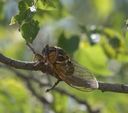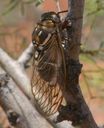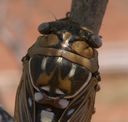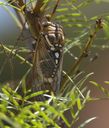Megatibicen
Megatibicen
Classification
- Phylum: Arthropoda
- Subphylum: Hexapoda
- Class: Insecta
- Order: Hemiptera
- Suborder: Auchenorrhyncha
- Infraorder: Cicadomorpha
- Superfamily: Cicadoidea
- Family: Cicadidae
- Subfamily: Cicadinae
- Tribe: Tacuini
- Genus: Megatibicen
Pronunciation
How to pronounce Megatibicen: //ˌmɛɡəˈtɪbɪˌkɛn//
These audio files are automatically generated. While they are not always 100% accurate, they are a good starting point.
Images






Summary
Megatibicen is a genus of cicadas within the family Cicadidae, comprised of about 10 species primarily found in North America. They are often large and stocky with a distinctive pruinose appearance and significant ecological roles.
Physical Characteristics
Most species are larger than 2.5 inches long including wings. They are often stockier in appearance and characteristically have a more pruinose (white powdery wax) surface than most species of Neotibicen.
Identification Tips
Look for larger body size (>2.5 inches) and pruinose surface, as well as distinctive songs which may aid in identification of species groupings.
Habitat
Found in a variety of habitats, including forests, flood plains, and urban areas across North America.
Distribution
Primarily distributed throughout North America; species vary in their geographic ranges with some having western or eastern distributions.
Diet
Adult cicadas primarily feed on xylem fluid from tree roots and branches using their specialized mouthparts.
Life Cycle
Life cycle involves several nymphal stages, which can last for several years underground before emerging as adults.
Reproduction
Mating occurs in the evening; females lay eggs in slits made in tree bark, which can also affect tree health over time.
Predators
Predators include birds, mammals, and other insects that feed on cicadas during their emergence.
Ecosystem Role
Play a role in nutrient cycling and serve as prey for various predators; their emergence significantly influences local ecosystems.
Economic Impact
Potential impacts on forestry and agriculture due to feeding on plants; can affect tree health and yields in affected areas.
Cultural Significance
Cicadas are often a symbol of summer; they have cultural significance in various civilizations and are sometimes featured in art and literature.
Collecting Methods
- Netting during daytime when they are active
- Recording their songs to identify species
- Using light traps at night.
Preservation Methods
- Pinning
- Alcohol preservation for soft-bodied species
- Drying specimens for long-term storage.
Evolution
Recent classification has resulted in the distinction of Megatibicen from Neotibicen based on morphological and behavioral traits, along with genetic data.
Similar Taxa
- Neotibicen
- Tibicen
- Lyristes
Misconceptions
Cicadas are often confused with katydids or locusts, though they belong to different orders and families.
Tags
- cicadas
- Megatibicen
- North America
- insects
- entomology